译林版(2020)必修第三册Unit 1 Nature in the balance Reading 课件(共65张PPT)
文档属性
| 名称 | 译林版(2020)必修第三册Unit 1 Nature in the balance Reading 课件(共65张PPT) | 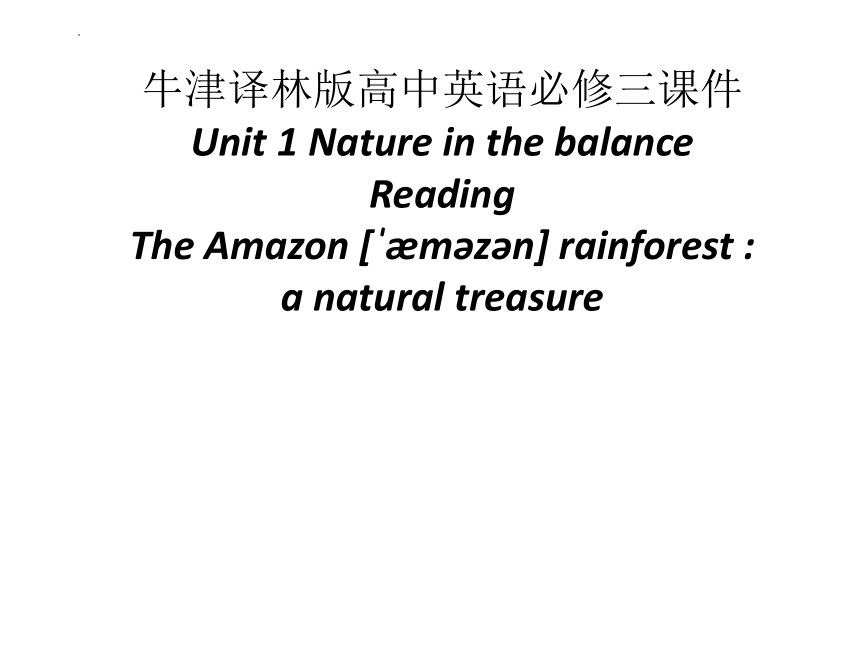 | |
| 格式 | pptx | ||
| 文件大小 | 811.2KB | ||
| 资源类型 | 教案 | ||
| 版本资源 | 牛津译林版(2019) | ||
| 科目 | 英语 | ||
| 更新时间 | 2023-08-14 11:05:43 | ||
图片预览

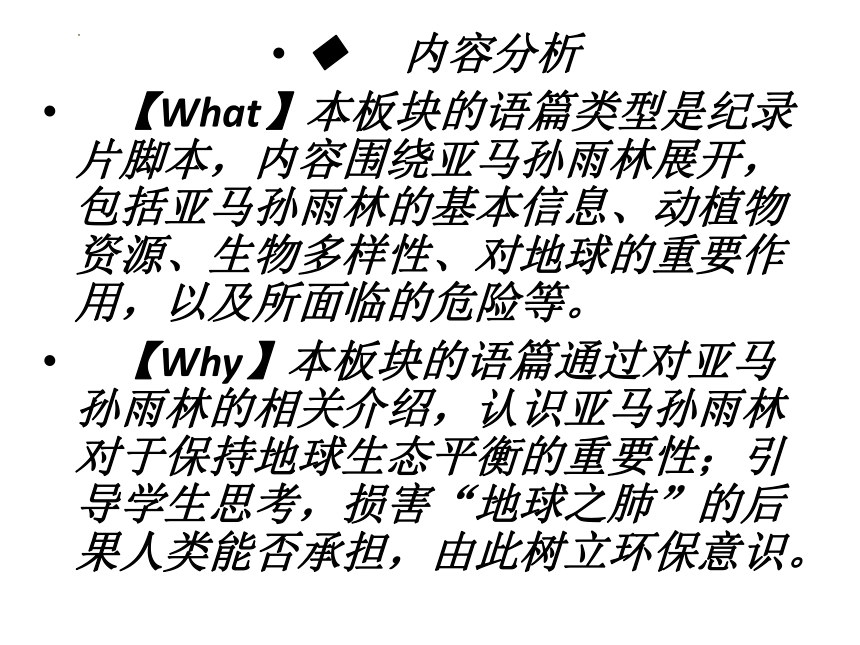
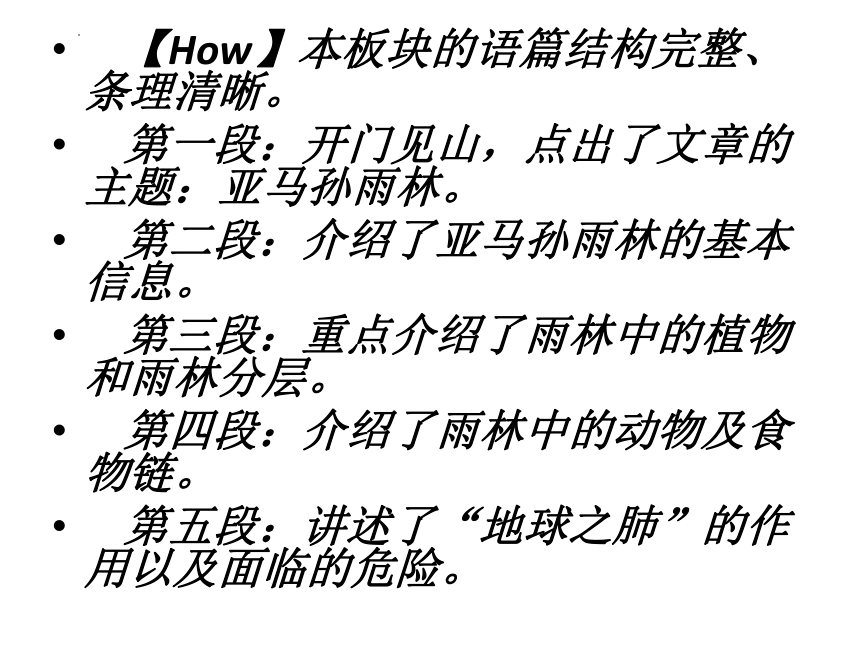

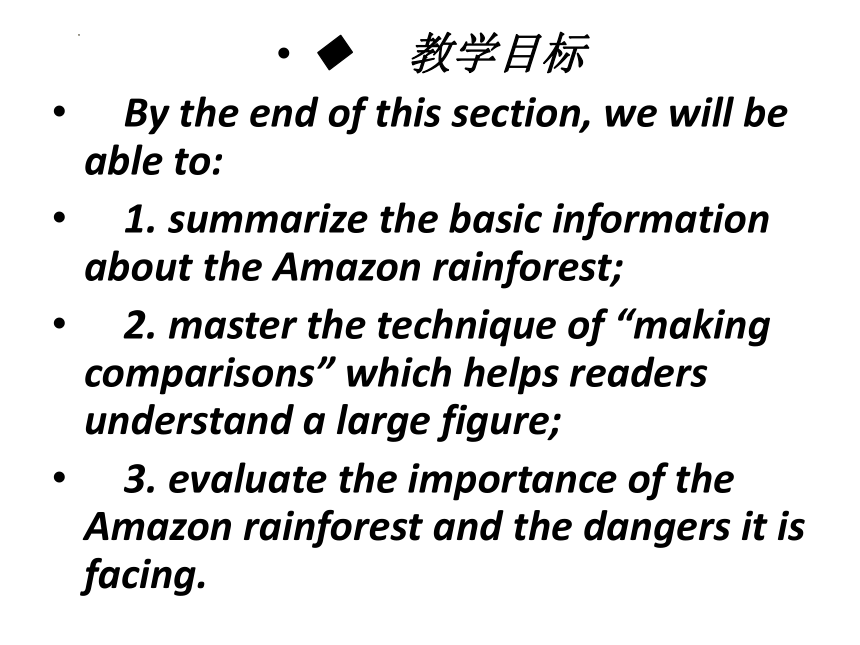
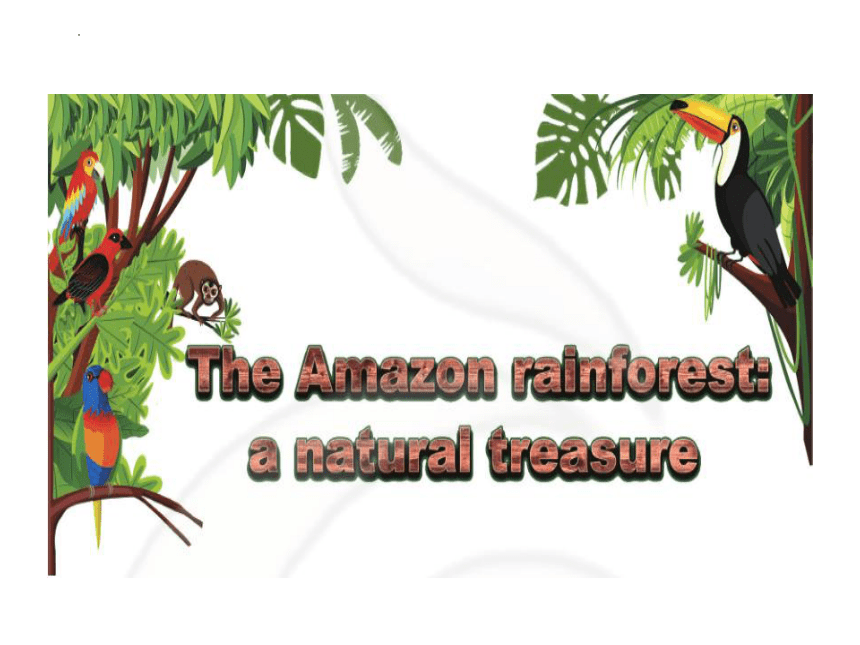
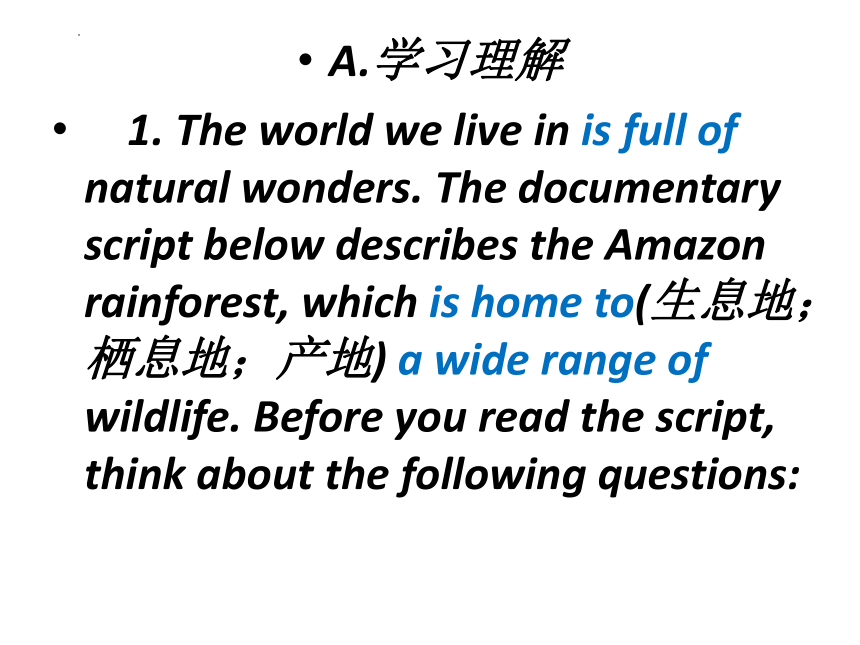
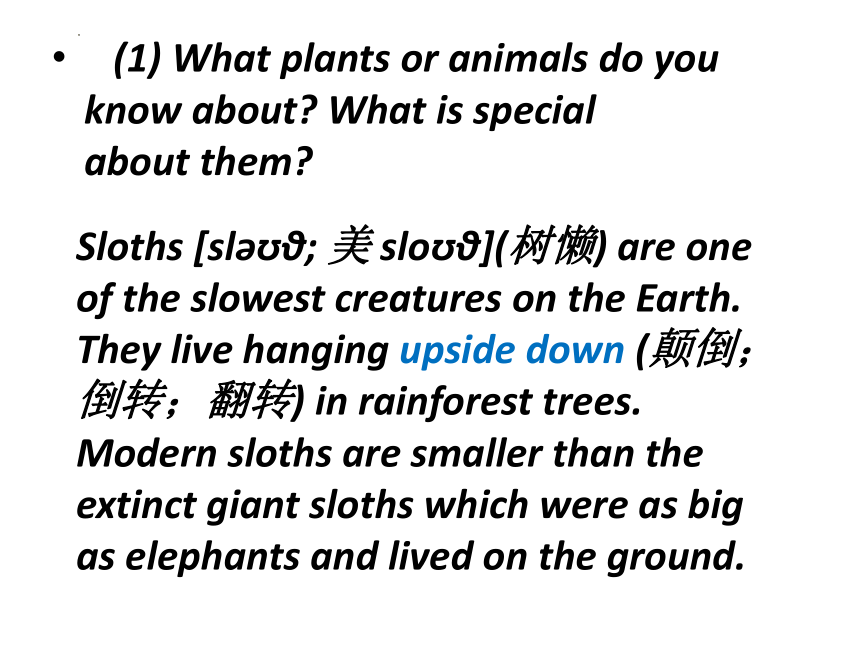
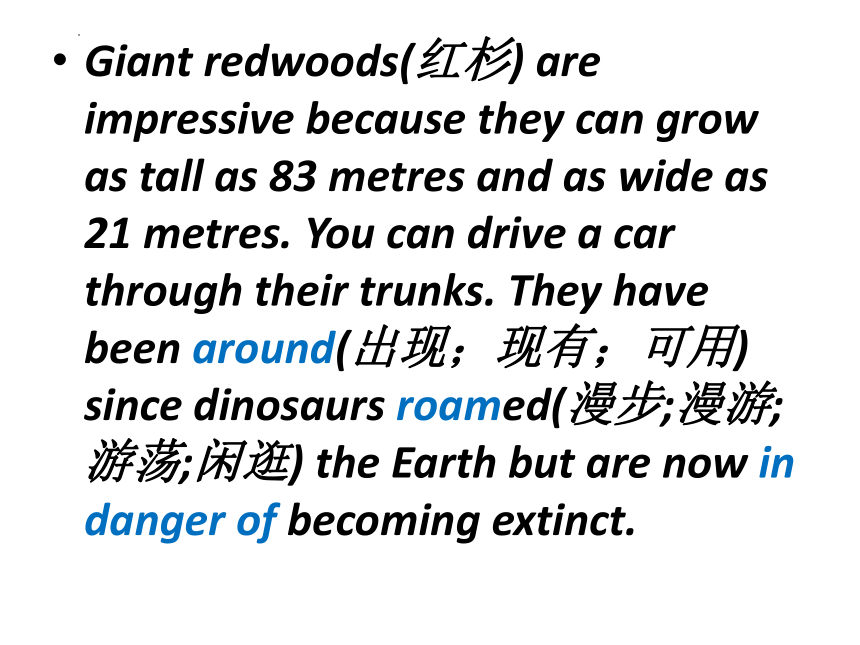
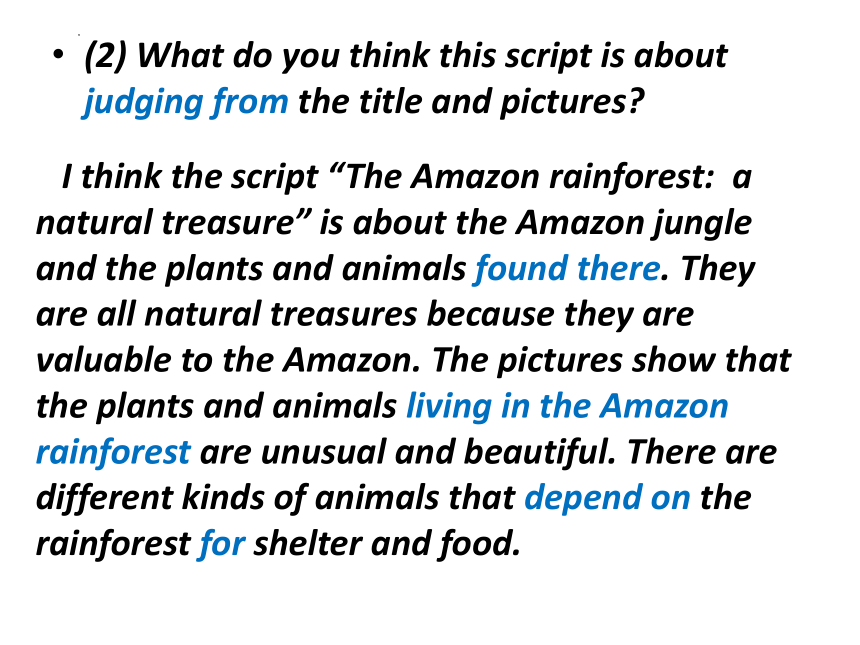
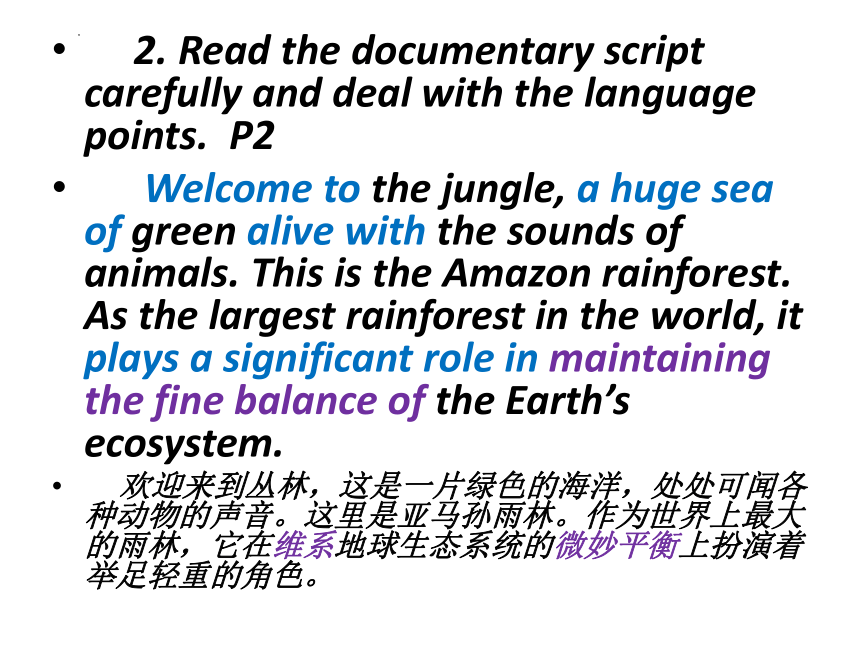
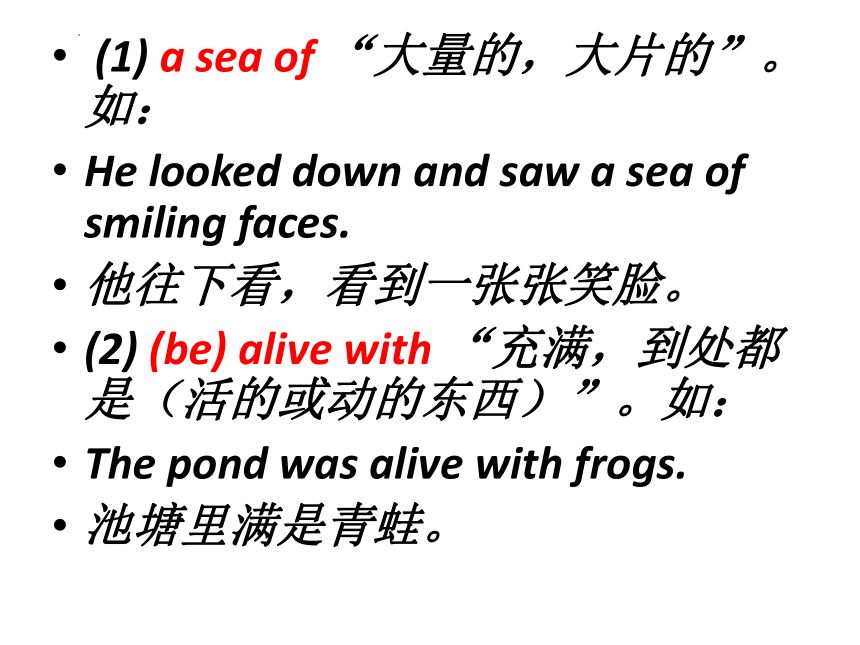
文档简介
(共65张PPT)
牛津译林版高中英语必修三课件
Unit 1 Nature in the balance
Reading
The Amazon [ m z n] rainforest :
a natural treasure
◆ 内容分析
【What】本板块的语篇类型是纪录片脚本,内容围绕亚马孙雨林展开,包括亚马孙雨林的基本信息、动植物资源、生物多样性、对地球的重要作用,以及所面临的危险等。
【Why】本板块的语篇通过对亚马孙雨林的相关介绍,认识亚马孙雨林对于保持地球生态平衡的重要性;引导学生思考,损害“地球之肺”的后果人类能否承担,由此树立环保意识。
【How】本板块的语篇结构完整、条理清晰。
第一段:开门见山,点出了文章的主题:亚马孙雨林。
第二段:介绍了亚马孙雨林的基本信息。
第三段:重点介绍了雨林中的植物和雨林分层。
第四段:介绍了雨林中的动物及食物链。
第五段:讲述了“地球之肺”的作用以及面临的危险。
本文本质上属于说明文,具备这种文本类型的主要特点:内容科学、结构严谨、语言严密准确。常见的说明方法如举例子、分类别、作比较、列数字等,在本文中均有体现。教学中要注意引导学生分析语篇特征,实现深度学习。
◆ 教学目标
By the end of this section, we will be able to:
1. summarize the basic information about the Amazon rainforest;
2. master the technique of “making comparisons” which helps readers understand a large figure;
3. evaluate the importance of the Amazon rainforest and the dangers it is facing.
A.学习理解
1. The world we live in is full of natural wonders. The documentary script below describes the Amazon rainforest, which is home to(生息地;栖息地;产地) a wide range of wildlife. Before you read the script, think about the following questions:
(1) What plants or animals do you know about What is special about them
Sloths [sl θ; 美 slo θ](树懒) are one of the slowest creatures on the Earth. They live hanging upside down (颠倒;倒转;翻转) in rainforest trees. Modern sloths are smaller than the extinct giant sloths which were as big as elephants and lived on the ground.
Giant redwoods(红杉) are impressive because they can grow as tall as 83 metres and as wide as 21 metres. You can drive a car through their trunks. They have been around(出现;现有;可用) since dinosaurs roamed(漫步;漫游;游荡;闲逛) the Earth but are now in danger of becoming extinct.
(2) What do you think this script is about judging from the title and pictures
I think the script “The Amazon rainforest: a natural treasure” is about the Amazon jungle and the plants and animals found there. They are all natural treasures because they are valuable to the Amazon. The pictures show that the plants and animals living in the Amazon rainforest are unusual and beautiful. There are different kinds of animals that depend on the rainforest for shelter and food.
2. Read the documentary script carefully and deal with the language points. P2
Welcome to the jungle, a huge sea of green alive with the sounds of animals. This is the Amazon rainforest. As the largest rainforest in the world, it plays a significant role in maintaining the fine balance of the Earth’s ecosystem.
欢迎来到丛林,这是一片绿色的海洋,处处可闻各种动物的声音。这里是亚马孙雨林。作为世界上最大的雨林,它在维系地球生态系统的微妙平衡上扮演着举足轻重的角色。
(1) a sea of “大量的,大片的”。如:
He looked down and saw a sea of smiling faces.
他往下看,看到一张张笑脸。
(2) (be) alive with “充满,到处都是(活的或动的东西)”。如:
The pond was alive with frogs.
池塘里满是青蛙。
The Amazon rainforest crosses into eight countries, including Brazil and Peru [p ru ] , and one overseas region of France, all on the South American continent. With an area of around 6 million square kilometres, the Amazon rainforest is more than half the size of China.
cross (over) (from…) (to/into…) | cross (over) (sth) 穿越;越过;横过;渡过
I waved and she crossed over (= crossed the road towards me) .
我挥了挥手,她便横穿马路朝我走来。
to cross the sea/mountains
越过大海;翻越高山
He crossed over the road and joined me.
他穿过马路和我走到了一块儿。
The bridge crosses the River Dee.
这座桥横跨迪河。
A look of annoyance crossed her face .
恼怒的神色从她脸上掠过。
They crossed the finishing line together (= in a race) .他们同时越过终点线。
The Amazon River, from which the rainforest gets its name, is close to 6,400 kilometres in length—roughly 100 kilometres longer than the Yangtze [ jɑ tsi] River. On its journey from the mountains to the ocean, the river supports many different ecosystems.
这条河从高山流向海洋,沿途维系着多种不同的生态系统。
They give this area the richest biodiversity on the Earth: one in ten known species in the world can be found here.
known|n n; 美 no n| adj.
[只用于名词前] 知名的;出了名的;已知的
He's a known thief.
他是个出了名的小偷。
The disease has no known cure.
这种病目前还是不治之症。
Of the 390,000 plant species known to us, more than 40,000 can be found in the Amazon. This tall and ancient brazil nut tree produces nuts that we can eat; these water lilies are big enough to lie down[躺下(休息或睡眠)] on. The forest’s different levels support(养活) an unbelievable variety of wildlife.雨林的不同层次养活的野生动物种类多到难以置信。
support养活;赡养;扶养;维持
Mark has two children to support from his first marriage.马克得扶养他第一次婚姻生的两个孩子。
The atmosphere of Mars could not support life.
生命无法在火星的大气环境下生存。
At the bottom, there is a system of roots beneath the ground. Above that is the mass of leaf litter on the dark forest floor. The next level is made up of shorter plants with large leaves.
最底层是地下的根系。往上是阴暗森林地表厚实的落叶层。再往上一层由低矮的阔叶植物组成。
Then there are the towering ancient hardwoods, and finally the tops of the tallest trees many metres above the ground. Each level of the forest forms its own little world, home to different kinds of living things.
然后是高耸、古老的阔叶树,最后是那些离地数米之高的大树的树冠。雨林的每一层都自成一个小世界,成为各种生物的家园。
More than 1,300 species of birds and over 400 species of mammals hide among the jungle’s plant life. This jaguar is one example. It has a yellowish-brown coat(动物皮毛) with black spots. While a significant number of jaguars survive here, they are only one element of this forest’s food chain(食物链).
while (用于句首) : although; despite the fact that… 虽然;尽管
While I am willing to help, I do not have much time available.
尽管我愿意帮忙,但是没有多少时间。
the food chain食物链
Insects are fairly low down (on) the food chain.在食物链中,昆虫是相当低的一级生物。
They feed on at least 87 species, including frogs. These frogs, in turn, feed on insects which eat leaves and fruit. When a jaguar dies, a tiny army (大批;大群) of microorganisms helps break down its body and return the nutrients to the earth.
feed on/off sth
A. (动物) 以…为食
Butterflies feed on the flowers of garden plants.
蝴蝶以园林中草木的花为食。
B. (often disapproving) 因…而壮大;从…中得到滋养
Racism [ re s z m] feeds on fear.
恐惧心理会助长种族主义。
The Amazon rainforest breathes life into the planet by fixing(使固定) carbon and producing over 20 per cent of all the Earth’s oxygen. Thus, it is often known as the “lungs of the planet”. Moreover, the Amazon rainforest is a treasure house (宝库;宝地) of species that can be used for food or medicine. Yet there is one major danger to these irreplaceable plants and animals: us.
Over the past 50 years, about 17 per cent of the rainforest has disappeared due to human activities such as agriculture and cattle farming. As the impact of human activities continues to grow and the list of species in danger of extinction becomes longer, we are left with a question: can we afford to damage the “lungs of the planet”
leave sb. with sth.
A.(尤指把令人不快或困难的事)留给,扔给(某人)
He left me with a child to support.
他扔下我独自拉扯一个孩子。
B.限制(某人于某一行动或机会)
He was left with no option but to resign. 他除了辞职外别无选择。
afford(通常与can或could连用,尤用于否定句或疑问句) 承担得起(后果)
We cannot afford to ignore this warning.
我们对这个警告绝不能等闲视之。
We cannot afford any more delays.
我们不能再有任何耽搁了。
3. Read the documentary script again and write the main idea of each paragraph. Page 4
Para. 1: Introduction to the Amazon rainforest
Para. 2: Basic information about the rainforest
Para. 3:______________________
_______________
Plant biodiversity; levels of the rainforest
Para. 4: ______________________
______________________________
Para. 5:______________________
______________________________
______________________________
Animal biodiversity; food chain
The rainforest’s value to the human race; threats to the rainforest
4. Finish A2 on page 4.
A2. Read the documentary script again carefully and fill in the blanks with the figures.
8
6 million
6,400
40,000
1300
400
20%
17%
5. Read paragraph 3 and complete the following mind map about the different levels of the forest.
the mass of leaf litter
shorter plants with large leaves
towering ancient hardwoods
the tops of the tallest trees
6. Read paragraph 4 and complete the following chart about the food chain in the rainforest.
insects
frogs
jaguars
microorganisms
B.应用实践
1. Get detailed information about the documentary script by finishing the following tasks.
(1) Fill in the following chart based on the documentary script.
the Amazon River
biodiversity
plant species
levels
mammals
food chain
oxygen
food or medicine
us/human beings
agriculture
(2) Have students summarize the documentary script based on the chart above.
The Amazon rainforest is on the South American continent, covering an area of around 6 million square kilometres. The Amazon rainforest gets its name from the Amazon River, which is about 6,400 kilometres in length. Different
ecosystems supported by the Amazon River give this area the richest biodiversity on the Earth.
More than 40,000 plant species can be found in the Amazon rainforest. The different levels of the forest support a great variety of wildlife and each level forms its own little world. More than 1,300 species of birds and over 400 species of mammals can be found here. All these species are the elements of this forest’s food chain.
Known as the “lungs of the planet”, the Amazon rainforest breathes life into the planet by fixing carbon and producing oxygen. And there are many species that can be used for food or medicine.
The forest faces a major danger from us. Human activities such as agriculture and cattle farming are affecting the rainforest.
2. Answer the following questions.
(1) Answer question 1 and 2 of A3 on page 4.
① What makes the Amazon rainforest a natural treasure according to the script
The Amazon rainforest is unique, beautiful and valuable. It contains 10% of all known species on the Earth. It produces over 20% of the planet’s oxygen. Its wonderful plant and animal species have enabled humans to make amazing discoveries.
② What is your answer to the question at the end of the script Support your opinion with information from the script or other sources.
No. The Amazon rainforest is far too important for us to allow it to be destroyed. It helps maintain the balance of the ecosystem and provides our society with food and medicine.
(2) In the sentence “Yet there is one major danger to these irreplaceable plants and animals: us.” (page 3, lines 33 — 34), why “us” is used instead of “human beings” here
By using “us” instead of “human beings”, the author wants to emphasize that every one of us is responsible for the damage to the rainforest. Therefore, all of us have a part to play in protecting it.
3. Finish B1 on page 5.
B1. The passage below is from a website about the Amazon plete the passage with the correct forms of the words and phrases in the box below.
agriculture impact thus due to
variety survive beneath break down
The Amazon rainforest is home to a great (1) _______ of plant life; however, its soil is surprisingly poor (缺乏;贫乏;缺少) in nutrients. In fact, the soil in the region cannot support (2) _________ for more than a few years. If a scientist is shown a report listing the nutrients of that soil, he or she will probably think that only desert plants can (3) _______ in it!
variety
agriculture
survive
Then why is the soil so poor in nutrients For one thing, the rainy season has a(n) (4) _______ on the soil. In the rainy season, the water level(水位) can rise to more than 12 metres. When the water goes away, it takes away the nutrients in the soil. For another thing, (5) _______ the Amazon’s hot climate, it is difficult for the soil to build up(逐渐增加) enough nutrients.
impact
due to
Dead plants and animals (6) ___
___________ more quickly. The nutrients are soon taken in by the roots of the plants deep (7) _______ the ground. As a result, most of the forest’s nutrients are locked up in the plants themselves, (8) _____ allowing them to grow at an unbelievable speed.
are
broken down
beneath
thus
4. Finish B2 on page 5.
B2. The documentary script uses some words with negative prefixes ['pri,f ks]. Note the following prefixes and think of more words formed with them. Then fill in the table below with as many words as you can.
Prefixes Words
un-
dis-
in-/im-/il-/ir-
non-
unbelievable, unlimited, unhappy, unknown, unusual, unreal, unfortunate, unlucky, unkind
disappear, disagree, disadvantage, dissatisfied, dishonest, disabled
irreplaceable, invisible, incorrect, inactive, independent, impolite, imbalance, illegal, irregular, irresponsible
non-smoking, non-stop, non-existent, non-profit, non-fiction
5. Finish B3 on page 5.
B3. The documentary script compares the size of the Amazon rainforest with that of China,and the length of the Amazon River with that of the Yangtze River. Find these comparisons in the script and think of similar comparisons for the figures below.
Learn this: While the reader may find a large figure too abstract to understand, making comparisons with familiar places or objects will help them gain a better understanding. Here are some expressions used to make comparisons:
the same size/length as ...
as large/long as ...
more than/larger than/longer than ...
twice/three times as large/long as …
Sentences using comparison:
With an area of around 6 million square kilometres, the Amazon rainforest is more than half the size of China.
The Amazon River, from which the rainforest gets its name, is close to 6,400 kilometres in length—roughly 100 kilometres longer than the Yangtze River.
(1) It was reported that in 2011, about 34 million people lived in the Amazon. (population of Canada: 37 million; population of Shanghai: 24 million)
It was reported that in 2011, about 34 million people lived in the Amazon—that is about Canada’s total population.
It was reported that in 2011, about 34 million people lived in the Amazon—that is 10 million more than the population of Shanghai.
(2) From 2001 to 2012, about 177,000 square kilometres of the Amazon rainforest were lost. (size of New Zealand: 268,000 km 2 ; size of Jiangsu: 107,200 km 2 )
From 2001 to 2012, about 177,000 square kilometres of the Amazon rainforest were lost—that is more than half the size of New Zealand.
From 2001 to 2012, about 177,000 square kilometres of the Amazon rainforest were lost—that is about twice the size of Jiangsu.
C. 迁移创新
1. Answer the third question of A3 on page 4.
Are there any places in China with rich biodiversity like the Amazon rainforest What are they Introduce one to the class.
The Three Parallel [ p r lel] Rivers of Yunnan Protected Areas(云南三江并流保护区) is a natural property consisting of 15 protected areas. The property is of outstanding value for its diversity of landscapes and rich biodiversity. In its 15 different protected areas, there are over 6,000 plant species, around 200 mammal species and more than 400 bird species.
A large number of rare animals such as Yunnan golden monkeys, snow leopards [ lep d; 美 - rd] and black necked cranes(黑颈鹤) can be found here.
2. Discuss the Ant Forest Programme and share their opinions in class.
(1) What is the Ant Forest Programme(蚂蚁森林)
The Ant Forest Programme is an innovative [ n ve t v] approach coming from a mobile Internet financial service company of China. It aims to combine the Internet, finance and a low-carbon lifestyle to turn virtual trees that users grow on the online platform into real ones. This move contributes to the growth of the number of trees in China, as well as to protecting the environment.
(2) How does the Ant Forest Programme work
In the Ant Forest Programme, any activities of the user that are considered low-carbon can be counted and converted [k n v :t; 美 - v :rt][ (使)转变,转换,转化] into virtual “green energy”. These activities include walking instead of driving, paying for utilities (公用事业) [ju:'t l t z] and buying tickets online, taking public transport and so on.
The so-called virtual “green energy” generated by such activities are saved in the user’s “Ant Forest” account. When enough “energy” has been accumulated [ k'ju:mj le t d] to grow a virtual tree, it will be converted into a real tree, planted by the staff.
(3) Do you support the Ant Forest Programme and why
Yes, I like this programme very much. Firstly, the idea that a real tree could be planted as long as I keep on taking part in low-carbon activities definitely helps me choose an environment-friendly lifestyle.
Secondly, the Ant Forest Programme has a lot of fun because it has many social interaction functions, such as watering friends’ trees or “stealing” green energy from them. Thirdly, I think it enables us to have a better understanding of environmental protection and makes our contributions mean[ (某事)对(某人)很重要,要紧,意义重大] something, no matter how small they are.
牛津译林版高中英语必修三课件
Unit 1 Nature in the balance
Reading
The Amazon [ m z n] rainforest :
a natural treasure
◆ 内容分析
【What】本板块的语篇类型是纪录片脚本,内容围绕亚马孙雨林展开,包括亚马孙雨林的基本信息、动植物资源、生物多样性、对地球的重要作用,以及所面临的危险等。
【Why】本板块的语篇通过对亚马孙雨林的相关介绍,认识亚马孙雨林对于保持地球生态平衡的重要性;引导学生思考,损害“地球之肺”的后果人类能否承担,由此树立环保意识。
【How】本板块的语篇结构完整、条理清晰。
第一段:开门见山,点出了文章的主题:亚马孙雨林。
第二段:介绍了亚马孙雨林的基本信息。
第三段:重点介绍了雨林中的植物和雨林分层。
第四段:介绍了雨林中的动物及食物链。
第五段:讲述了“地球之肺”的作用以及面临的危险。
本文本质上属于说明文,具备这种文本类型的主要特点:内容科学、结构严谨、语言严密准确。常见的说明方法如举例子、分类别、作比较、列数字等,在本文中均有体现。教学中要注意引导学生分析语篇特征,实现深度学习。
◆ 教学目标
By the end of this section, we will be able to:
1. summarize the basic information about the Amazon rainforest;
2. master the technique of “making comparisons” which helps readers understand a large figure;
3. evaluate the importance of the Amazon rainforest and the dangers it is facing.
A.学习理解
1. The world we live in is full of natural wonders. The documentary script below describes the Amazon rainforest, which is home to(生息地;栖息地;产地) a wide range of wildlife. Before you read the script, think about the following questions:
(1) What plants or animals do you know about What is special about them
Sloths [sl θ; 美 slo θ](树懒) are one of the slowest creatures on the Earth. They live hanging upside down (颠倒;倒转;翻转) in rainforest trees. Modern sloths are smaller than the extinct giant sloths which were as big as elephants and lived on the ground.
Giant redwoods(红杉) are impressive because they can grow as tall as 83 metres and as wide as 21 metres. You can drive a car through their trunks. They have been around(出现;现有;可用) since dinosaurs roamed(漫步;漫游;游荡;闲逛) the Earth but are now in danger of becoming extinct.
(2) What do you think this script is about judging from the title and pictures
I think the script “The Amazon rainforest: a natural treasure” is about the Amazon jungle and the plants and animals found there. They are all natural treasures because they are valuable to the Amazon. The pictures show that the plants and animals living in the Amazon rainforest are unusual and beautiful. There are different kinds of animals that depend on the rainforest for shelter and food.
2. Read the documentary script carefully and deal with the language points. P2
Welcome to the jungle, a huge sea of green alive with the sounds of animals. This is the Amazon rainforest. As the largest rainforest in the world, it plays a significant role in maintaining the fine balance of the Earth’s ecosystem.
欢迎来到丛林,这是一片绿色的海洋,处处可闻各种动物的声音。这里是亚马孙雨林。作为世界上最大的雨林,它在维系地球生态系统的微妙平衡上扮演着举足轻重的角色。
(1) a sea of “大量的,大片的”。如:
He looked down and saw a sea of smiling faces.
他往下看,看到一张张笑脸。
(2) (be) alive with “充满,到处都是(活的或动的东西)”。如:
The pond was alive with frogs.
池塘里满是青蛙。
The Amazon rainforest crosses into eight countries, including Brazil and Peru [p ru ] , and one overseas region of France, all on the South American continent. With an area of around 6 million square kilometres, the Amazon rainforest is more than half the size of China.
cross (over) (from…) (to/into…) | cross (over) (sth) 穿越;越过;横过;渡过
I waved and she crossed over (= crossed the road towards me) .
我挥了挥手,她便横穿马路朝我走来。
to cross the sea/mountains
越过大海;翻越高山
He crossed over the road and joined me.
他穿过马路和我走到了一块儿。
The bridge crosses the River Dee.
这座桥横跨迪河。
A look of annoyance crossed her face .
恼怒的神色从她脸上掠过。
They crossed the finishing line together (= in a race) .他们同时越过终点线。
The Amazon River, from which the rainforest gets its name, is close to 6,400 kilometres in length—roughly 100 kilometres longer than the Yangtze [ jɑ tsi] River. On its journey from the mountains to the ocean, the river supports many different ecosystems.
这条河从高山流向海洋,沿途维系着多种不同的生态系统。
They give this area the richest biodiversity on the Earth: one in ten known species in the world can be found here.
known|n n; 美 no n| adj.
[只用于名词前] 知名的;出了名的;已知的
He's a known thief.
他是个出了名的小偷。
The disease has no known cure.
这种病目前还是不治之症。
Of the 390,000 plant species known to us, more than 40,000 can be found in the Amazon. This tall and ancient brazil nut tree produces nuts that we can eat; these water lilies are big enough to lie down[躺下(休息或睡眠)] on. The forest’s different levels support(养活) an unbelievable variety of wildlife.雨林的不同层次养活的野生动物种类多到难以置信。
support养活;赡养;扶养;维持
Mark has two children to support from his first marriage.马克得扶养他第一次婚姻生的两个孩子。
The atmosphere of Mars could not support life.
生命无法在火星的大气环境下生存。
At the bottom, there is a system of roots beneath the ground. Above that is the mass of leaf litter on the dark forest floor. The next level is made up of shorter plants with large leaves.
最底层是地下的根系。往上是阴暗森林地表厚实的落叶层。再往上一层由低矮的阔叶植物组成。
Then there are the towering ancient hardwoods, and finally the tops of the tallest trees many metres above the ground. Each level of the forest forms its own little world, home to different kinds of living things.
然后是高耸、古老的阔叶树,最后是那些离地数米之高的大树的树冠。雨林的每一层都自成一个小世界,成为各种生物的家园。
More than 1,300 species of birds and over 400 species of mammals hide among the jungle’s plant life. This jaguar is one example. It has a yellowish-brown coat(动物皮毛) with black spots. While a significant number of jaguars survive here, they are only one element of this forest’s food chain(食物链).
while (用于句首) : although; despite the fact that… 虽然;尽管
While I am willing to help, I do not have much time available.
尽管我愿意帮忙,但是没有多少时间。
the food chain食物链
Insects are fairly low down (on) the food chain.在食物链中,昆虫是相当低的一级生物。
They feed on at least 87 species, including frogs. These frogs, in turn, feed on insects which eat leaves and fruit. When a jaguar dies, a tiny army (大批;大群) of microorganisms helps break down its body and return the nutrients to the earth.
feed on/off sth
A. (动物) 以…为食
Butterflies feed on the flowers of garden plants.
蝴蝶以园林中草木的花为食。
B. (often disapproving) 因…而壮大;从…中得到滋养
Racism [ re s z m] feeds on fear.
恐惧心理会助长种族主义。
The Amazon rainforest breathes life into the planet by fixing(使固定) carbon and producing over 20 per cent of all the Earth’s oxygen. Thus, it is often known as the “lungs of the planet”. Moreover, the Amazon rainforest is a treasure house (宝库;宝地) of species that can be used for food or medicine. Yet there is one major danger to these irreplaceable plants and animals: us.
Over the past 50 years, about 17 per cent of the rainforest has disappeared due to human activities such as agriculture and cattle farming. As the impact of human activities continues to grow and the list of species in danger of extinction becomes longer, we are left with a question: can we afford to damage the “lungs of the planet”
leave sb. with sth.
A.(尤指把令人不快或困难的事)留给,扔给(某人)
He left me with a child to support.
他扔下我独自拉扯一个孩子。
B.限制(某人于某一行动或机会)
He was left with no option but to resign. 他除了辞职外别无选择。
afford(通常与can或could连用,尤用于否定句或疑问句) 承担得起(后果)
We cannot afford to ignore this warning.
我们对这个警告绝不能等闲视之。
We cannot afford any more delays.
我们不能再有任何耽搁了。
3. Read the documentary script again and write the main idea of each paragraph. Page 4
Para. 1: Introduction to the Amazon rainforest
Para. 2: Basic information about the rainforest
Para. 3:______________________
_______________
Plant biodiversity; levels of the rainforest
Para. 4: ______________________
______________________________
Para. 5:______________________
______________________________
______________________________
Animal biodiversity; food chain
The rainforest’s value to the human race; threats to the rainforest
4. Finish A2 on page 4.
A2. Read the documentary script again carefully and fill in the blanks with the figures.
8
6 million
6,400
40,000
1300
400
20%
17%
5. Read paragraph 3 and complete the following mind map about the different levels of the forest.
the mass of leaf litter
shorter plants with large leaves
towering ancient hardwoods
the tops of the tallest trees
6. Read paragraph 4 and complete the following chart about the food chain in the rainforest.
insects
frogs
jaguars
microorganisms
B.应用实践
1. Get detailed information about the documentary script by finishing the following tasks.
(1) Fill in the following chart based on the documentary script.
the Amazon River
biodiversity
plant species
levels
mammals
food chain
oxygen
food or medicine
us/human beings
agriculture
(2) Have students summarize the documentary script based on the chart above.
The Amazon rainforest is on the South American continent, covering an area of around 6 million square kilometres. The Amazon rainforest gets its name from the Amazon River, which is about 6,400 kilometres in length. Different
ecosystems supported by the Amazon River give this area the richest biodiversity on the Earth.
More than 40,000 plant species can be found in the Amazon rainforest. The different levels of the forest support a great variety of wildlife and each level forms its own little world. More than 1,300 species of birds and over 400 species of mammals can be found here. All these species are the elements of this forest’s food chain.
Known as the “lungs of the planet”, the Amazon rainforest breathes life into the planet by fixing carbon and producing oxygen. And there are many species that can be used for food or medicine.
The forest faces a major danger from us. Human activities such as agriculture and cattle farming are affecting the rainforest.
2. Answer the following questions.
(1) Answer question 1 and 2 of A3 on page 4.
① What makes the Amazon rainforest a natural treasure according to the script
The Amazon rainforest is unique, beautiful and valuable. It contains 10% of all known species on the Earth. It produces over 20% of the planet’s oxygen. Its wonderful plant and animal species have enabled humans to make amazing discoveries.
② What is your answer to the question at the end of the script Support your opinion with information from the script or other sources.
No. The Amazon rainforest is far too important for us to allow it to be destroyed. It helps maintain the balance of the ecosystem and provides our society with food and medicine.
(2) In the sentence “Yet there is one major danger to these irreplaceable plants and animals: us.” (page 3, lines 33 — 34), why “us” is used instead of “human beings” here
By using “us” instead of “human beings”, the author wants to emphasize that every one of us is responsible for the damage to the rainforest. Therefore, all of us have a part to play in protecting it.
3. Finish B1 on page 5.
B1. The passage below is from a website about the Amazon plete the passage with the correct forms of the words and phrases in the box below.
agriculture impact thus due to
variety survive beneath break down
The Amazon rainforest is home to a great (1) _______ of plant life; however, its soil is surprisingly poor (缺乏;贫乏;缺少) in nutrients. In fact, the soil in the region cannot support (2) _________ for more than a few years. If a scientist is shown a report listing the nutrients of that soil, he or she will probably think that only desert plants can (3) _______ in it!
variety
agriculture
survive
Then why is the soil so poor in nutrients For one thing, the rainy season has a(n) (4) _______ on the soil. In the rainy season, the water level(水位) can rise to more than 12 metres. When the water goes away, it takes away the nutrients in the soil. For another thing, (5) _______ the Amazon’s hot climate, it is difficult for the soil to build up(逐渐增加) enough nutrients.
impact
due to
Dead plants and animals (6) ___
___________ more quickly. The nutrients are soon taken in by the roots of the plants deep (7) _______ the ground. As a result, most of the forest’s nutrients are locked up in the plants themselves, (8) _____ allowing them to grow at an unbelievable speed.
are
broken down
beneath
thus
4. Finish B2 on page 5.
B2. The documentary script uses some words with negative prefixes ['pri,f ks]. Note the following prefixes and think of more words formed with them. Then fill in the table below with as many words as you can.
Prefixes Words
un-
dis-
in-/im-/il-/ir-
non-
unbelievable, unlimited, unhappy, unknown, unusual, unreal, unfortunate, unlucky, unkind
disappear, disagree, disadvantage, dissatisfied, dishonest, disabled
irreplaceable, invisible, incorrect, inactive, independent, impolite, imbalance, illegal, irregular, irresponsible
non-smoking, non-stop, non-existent, non-profit, non-fiction
5. Finish B3 on page 5.
B3. The documentary script compares the size of the Amazon rainforest with that of China,and the length of the Amazon River with that of the Yangtze River. Find these comparisons in the script and think of similar comparisons for the figures below.
Learn this: While the reader may find a large figure too abstract to understand, making comparisons with familiar places or objects will help them gain a better understanding. Here are some expressions used to make comparisons:
the same size/length as ...
as large/long as ...
more than/larger than/longer than ...
twice/three times as large/long as …
Sentences using comparison:
With an area of around 6 million square kilometres, the Amazon rainforest is more than half the size of China.
The Amazon River, from which the rainforest gets its name, is close to 6,400 kilometres in length—roughly 100 kilometres longer than the Yangtze River.
(1) It was reported that in 2011, about 34 million people lived in the Amazon. (population of Canada: 37 million; population of Shanghai: 24 million)
It was reported that in 2011, about 34 million people lived in the Amazon—that is about Canada’s total population.
It was reported that in 2011, about 34 million people lived in the Amazon—that is 10 million more than the population of Shanghai.
(2) From 2001 to 2012, about 177,000 square kilometres of the Amazon rainforest were lost. (size of New Zealand: 268,000 km 2 ; size of Jiangsu: 107,200 km 2 )
From 2001 to 2012, about 177,000 square kilometres of the Amazon rainforest were lost—that is more than half the size of New Zealand.
From 2001 to 2012, about 177,000 square kilometres of the Amazon rainforest were lost—that is about twice the size of Jiangsu.
C. 迁移创新
1. Answer the third question of A3 on page 4.
Are there any places in China with rich biodiversity like the Amazon rainforest What are they Introduce one to the class.
The Three Parallel [ p r lel] Rivers of Yunnan Protected Areas(云南三江并流保护区) is a natural property consisting of 15 protected areas. The property is of outstanding value for its diversity of landscapes and rich biodiversity. In its 15 different protected areas, there are over 6,000 plant species, around 200 mammal species and more than 400 bird species.
A large number of rare animals such as Yunnan golden monkeys, snow leopards [ lep d; 美 - rd] and black necked cranes(黑颈鹤) can be found here.
2. Discuss the Ant Forest Programme and share their opinions in class.
(1) What is the Ant Forest Programme(蚂蚁森林)
The Ant Forest Programme is an innovative [ n ve t v] approach coming from a mobile Internet financial service company of China. It aims to combine the Internet, finance and a low-carbon lifestyle to turn virtual trees that users grow on the online platform into real ones. This move contributes to the growth of the number of trees in China, as well as to protecting the environment.
(2) How does the Ant Forest Programme work
In the Ant Forest Programme, any activities of the user that are considered low-carbon can be counted and converted [k n v :t; 美 - v :rt][ (使)转变,转换,转化] into virtual “green energy”. These activities include walking instead of driving, paying for utilities (公用事业) [ju:'t l t z] and buying tickets online, taking public transport and so on.
The so-called virtual “green energy” generated by such activities are saved in the user’s “Ant Forest” account. When enough “energy” has been accumulated [ k'ju:mj le t d] to grow a virtual tree, it will be converted into a real tree, planted by the staff.
(3) Do you support the Ant Forest Programme and why
Yes, I like this programme very much. Firstly, the idea that a real tree could be planted as long as I keep on taking part in low-carbon activities definitely helps me choose an environment-friendly lifestyle.
Secondly, the Ant Forest Programme has a lot of fun because it has many social interaction functions, such as watering friends’ trees or “stealing” green energy from them. Thirdly, I think it enables us to have a better understanding of environmental protection and makes our contributions mean[ (某事)对(某人)很重要,要紧,意义重大] something, no matter how small they are.
同课章节目录
- Unit 1 Nature in the balance
- Welcome to the unit
- Reading
- Grammar and usage
- Integrated skills
- Extended reading
- Project
- Unit 2 Natural disasters
- Welcome to the unit
- Reading
- Grammar and usage
- Integrated skills
- Extended reading
- Project
- Unit 3 The world online
- Welcome to the unit
- Reading
- Grammar and usage
- Integrated skills
- Extended reading
- Project
- Unit 4 Scientists who changed the world
- Welcome to the unit
- Reading
- Grammar and usage
- Integrated skills
- Extended reading
- Project
